Selling on Amazon can be a great way to grow your business, but it also comes with its own unique challenges. It is unfortunately not uncommon for Amazon sellers to receive IP infringement complaints, product misclassifications leading to the removal of your listings, or more serious issues such as “related account” suspensions.
Following a number of best practices and actively protecting your brand with IP registrations are a good way to reduce the chances of running up against these frustrating and often costly issues. In this article, we address some of the questions that Amazon sellers commonly ask us in relation to these topics. We provide you with valuable information and tips on how to avoid these issues and how to respond to them effectively if you do encounter them.
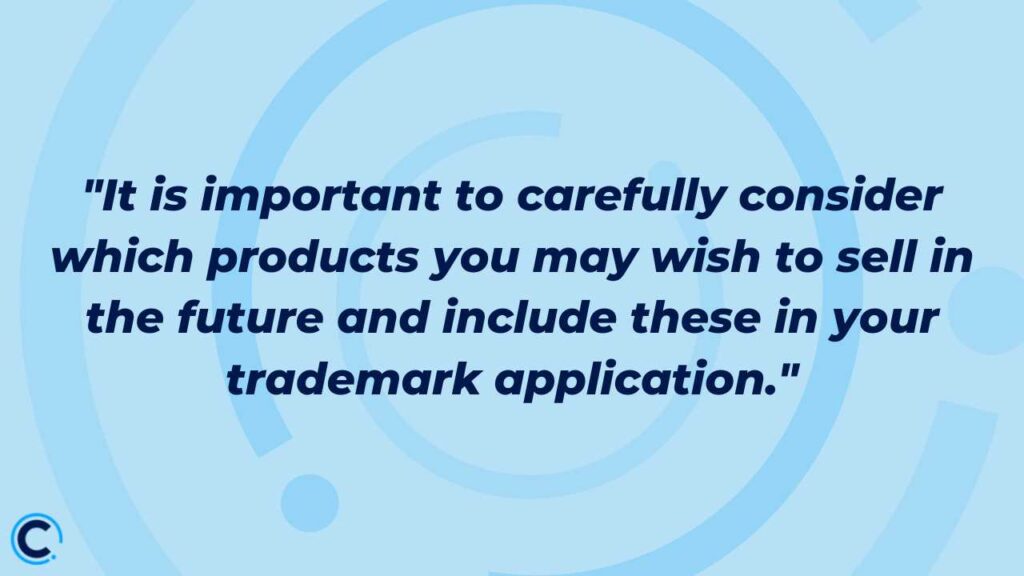
Once my trademark has been registered, am I covered for all types of products under this brand?
A trademark only covers the “goods and services” classes it was registered under, so it is important to carefully consider which products you may wish to sell in the future and include these in your trademark application. If you need your trademark to cover additional product classes after the application has been submitted to the USPTO, you will need to apply for a new trademark registration to cover these classes.
In addition, once you associate your listing with a brand, you cannot change the brand on that listing. Therefore, it is highly advisable that you apply for your trademark registration before you manufacture your product, packaging, and marketing materials and before you list your product on Amazon under your brand. A proper registration process should begin with research into the availability of the mark requested and an assessment of the likelihood of the mark being ultimately registered.
As to Brand Registry, a trademark application is all it takes to enroll in the program. With this program, you can enjoy a variety of benefits, including controlling your listing content and appearance; the ability to add enhanced A+ content, reducing the ability of third-party sellers to change your listing, and more. Once your trademark is accepted and registered with the trademark office, you will also be able to use the Brad Registry platform to enforce your rights and remove infringers who are using your mark without consent.
In order to reduce the likelihood of requiring a new trademark registration in the immediate future, a good amazon trademark attorney will be able to explain the various options and best practices and advise you which additional classes you may wish to consider including in your initial trademark registration.
Note: If you receive a trademark infringement complaint, it is a good idea to check the list of goods and services that the cited trademark is registered under. It is not uncommon for brands to submit complaints against sellers when their trademark doesn’t even cover the product they are trying to remove. Appealing to Amazon on this basis can be a successful strategy.
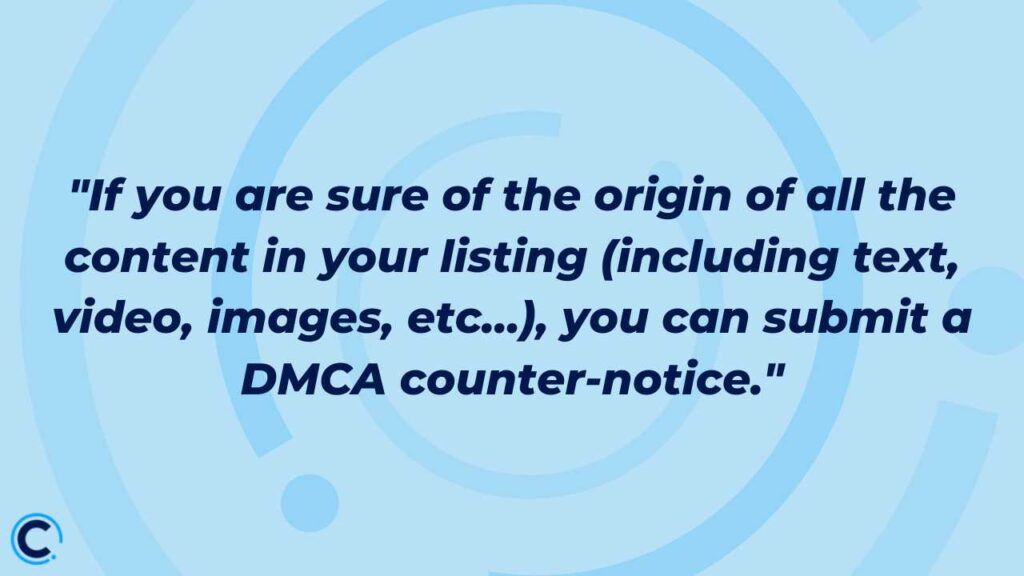
I received a copyright complaint but don’t think I am infringing, should I send a DMCA counter-notice? What can I do?
When a copyright complaint, called a “DMCA Takedown Notice”, is submitted to Amazon, they will remove the relevant listing to ensure that no allegedly infringing content remains publicly viewable, in accordance with stipulations contained in the Digital Millennium Copyright Act.
A DMCA Counter-Notice is an affidavit (a legal document) that you submit in response to a takedown notice, under penalty of perjury.
If you are sure of the origin of all the content in your listing (including text, video, images, etc…), you can submit a DMCA counter-notice. This is a legal response to claims of copyright infringement, which Amazon will forward to the complainant, who then has 10 business days to initiate formal court action to sue you and to provide proof of this to Amazon. If this does not happen, Amazon is required to reinstate the removed content within 10-14 days of receipt of your counter-notice.
Amazon (and other marketplaces) may provide a counter notice submission page as the only available option to dispute a copyright claim made via a DMCA Takedown Notice. It can be difficult to appeal outside of this route, however, it is sometimes possible. Ultimately, a DMCA counter-Notice is a legal response that exposes you to the possibility of being sued, so it is important to take legal advice before deciding how to appeal.
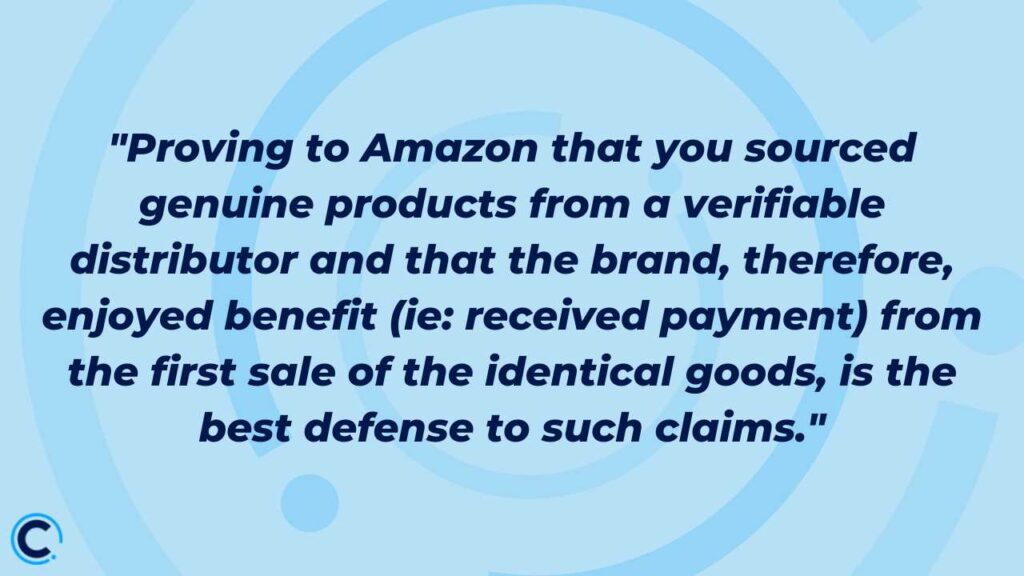
I received a trademark infringement complaint from a rights owner claiming that my product is counterfeit, how can I resolve this?
Generally speaking, a counterfeit complaint is an allegation that you are selling items that intentionally resemble trademarked goods, and that display an identical or nearly identical mark, in order to profit off the name of the established brand. Proving to Amazon that you sourced genuine products from a verifiable distributor and that the brand, therefore, enjoyed benefit (ie: received payment) from the first sale of the identical goods, is the best defense to such claims – this is generally referred to as the “First Sale Doctrine”. A brand is not entitled to make money from every sale of their products, on an ongoing basis, and a reseller can legally sell branded items as long as the seller doesn’t change the goods and the brand received a benefit from the initial sale of their products.
In practice, this means providing good invoices and full supplier details to Amazon. Amazon verifies suppliers in a number of ways and may contact them directly to check the invoices and other information, so it is important to always provide only genuine and verifiable information. Amazon also has strict rules for how invoices should look, what they should and should not contain, and how they are formatted, so if Amazon is rejecting your genuine documents, you should consult with an expert who can review and advise.
Having said that, each case is different, and the notification sent to you by Amazon may include useful information which can be directly addressed in the appeal, such as the Rights Owner’s comments, the trademark they claim is being infringed, and the complainant’s contact details. If appeals with supporting documents are not accepted, other options may be available, such as legal letters, contacting the rights owner to demand a retraction, or negotiating for their approval to use the trademark.
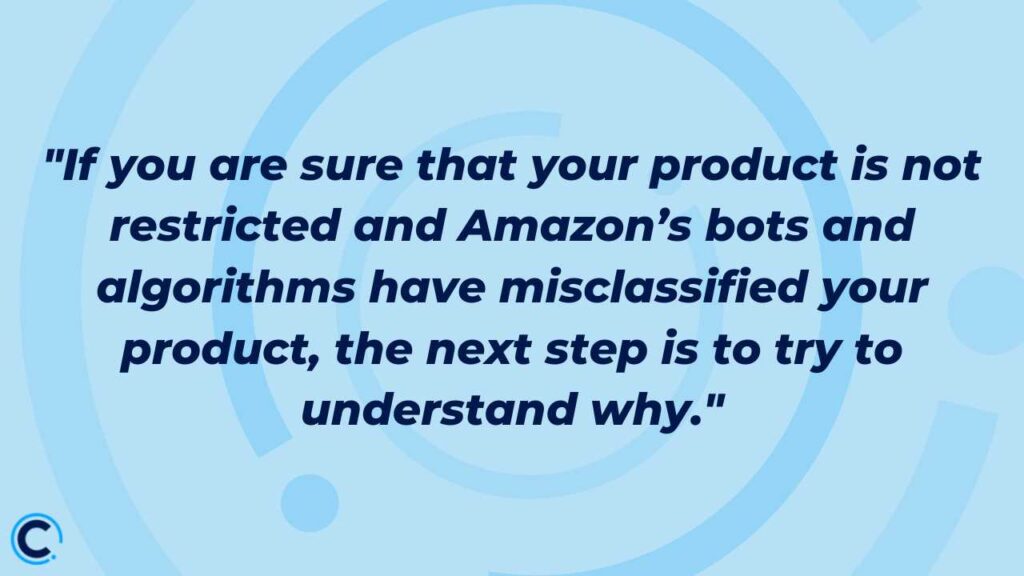
Amazon has misclassified my product as a restricted product, how do I respond?
When Amazon notifies you that one of your products is considered a restricted product, the first step is to carefully check if they are correct! Changes to relevant laws and regulations, as well as Amazon’s own policies, happen frequently and previously acceptable products can become legitimately restricted overnight.
If you are sure that your product is not restricted and Amazon’s bots and algorithms have misclassified your product, the next step is to try to understand why. For example, the use of specific everyday words or phrases in product listings may trigger genuine misclassifications, however, certain product claims may actually mean that your product now requires regulatory oversight and registration with Federal bodies, such as the EPA or FDA, so careful review of all listing content (including back-end search terms, etc…) is needed.
In many cases, the removal of problem language, or the submission of supporting documentation such as full ingredient lists, pictures of the product packaging, etc… can be used to appeal and reinstate the listing, however, the correct approach will depend on exactly what Amazon is claiming. For more complex cases, a review of the product and all marketing materials by a compliance expert may be advised. Providing Amazon with supporting letters, additional compliance testing and documentation, new warnings or labeling on the packaging, etc… may be needed before Amazon will consider reinstatement.
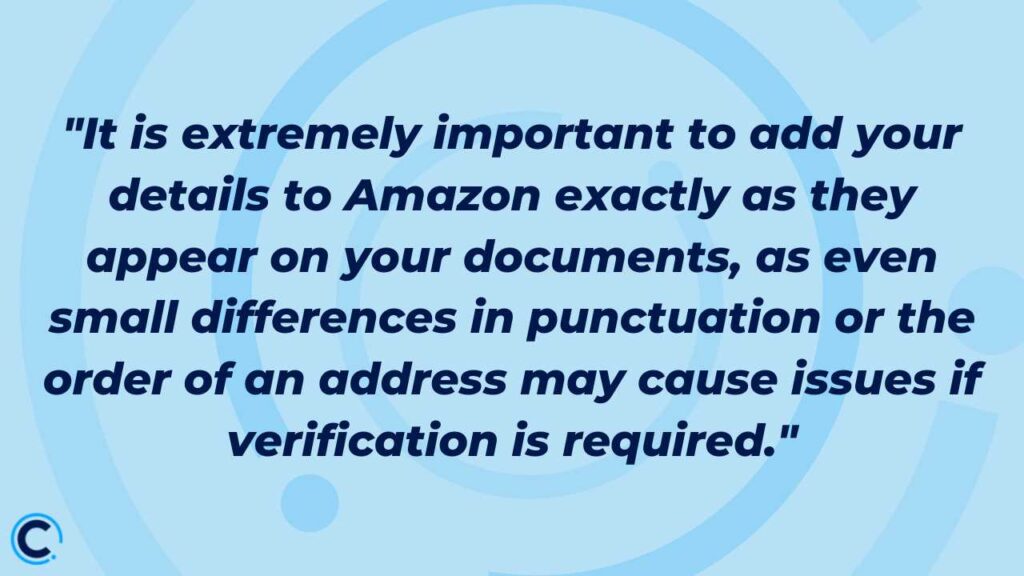
I need to change or update important details in my seller account, such as the legal entity, business address, deposit/charge methods, or login details – how can I do this correctly and reduce the chances of triggering Amazon’s verification process?
Amazon carefully monitors any changes made to important account details as this can be a sign that an account has been hijacked, hacked, or has been subject to other security breaches. Whilst it is possible to change all these details in your account, the process must be carried out with safety in mind, as Amazon will suspend or place accounts on hold if they believe that potentially suspicious activity has taken place. This may then trigger a verification process, which can be extremely frustrating and time-consuming.
Seller Identity verification is an unavoidable part of opening a new account, however, Amazon can also initiate verification for established, active seller accounts. For example, if the legal entity behind an active account is changed, such as when ownership changes hands, or an account owner moves the business from his own name to a new company, these important details should also be updated in your account. If done correctly, in the right order, and at the right pace, re-verification may be avoided, however, this can’t be guaranteed. As such, being prepared for re-verification is advised when changing account details.
It is extremely important to add your details to Amazon exactly as they appear on your documents, as even small differences in punctuation or the order of an address may cause issues if verification is required. Re-verification usually requires sellers to submit a government-issued ID document, a bank or credit card statement, and business documents such as articles of association, which must exactly match the information you entered into seller central. Once again, Amazon has very strict and specific requirements and will quickly reject documents that are not to their liking and many sellers get stuck in an extremely frustrating “rejection loop” at the verification stage, during which Amazon provides little to no assistance and will not even explain why your documents are being rejected.
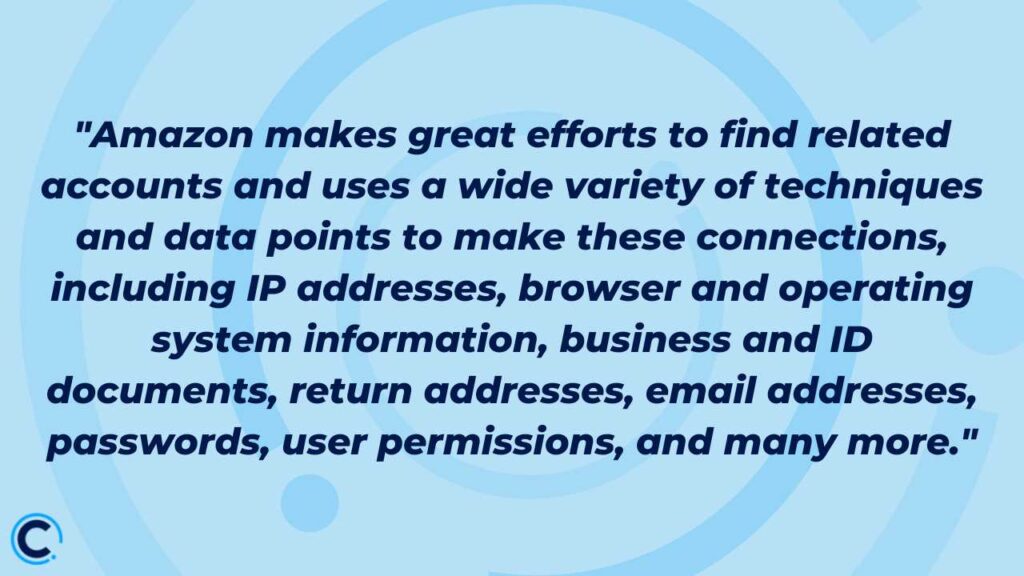
Amazon has suspended my account and is holding my funds, claiming that I own or am related to another selling account. How can I reopen my account?
Amazon views multiple selling accounts, connected to the same individual or entity, as a way to potentially evade the consequences of Amazon’s policy enforcement.
Amazon does allow individuals or entities to own and operate multiple selling accounts, as long as there is a “legitimate business need” (and your existing account is in good standing). However, Amazon’s policy is vague and leaves much room for interpretation. Opening a new or additional account because Amazon suspended your existing one (for whatever reason) is absolutely not considered a “legitimate business need”. Amazon will see this as an illicit attempt to circumvent Amazon’s ruling and might lead to a harsh or permanent suspension, which will be difficult to overcome.
Amazon makes great efforts to find related accounts and uses a wide variety of techniques and data points to make these connections, including IP addresses, browser and operating system information, business and ID documents, return addresses, email addresses, passwords, user permissions, and many more. Some of the techniques used to connect accounts are publicly known, but many are not. If Amazon believes that there is no “legitimate business need” for multiple accounts, or if one account is enforced for breaching Amazon’s policies, Amazon will suspend all related accounts simultaneously, even if these related accounts are in excellent health and have been running without issue for years.
There are two general approaches to resolving a related account suspension: either you must first reactivate the account that was initially enforced (you will usually be provided with the name or part of the name of the account Amazon claims you are related to); or, if you believe that you don’t currently own (or have rights to) the enforced account, even if you once did, you can appeal demonstrating to Amazon why the accounts are in fact unrelated. This requires a thorough investigation and a detailed appeal with supporting documentation. Amazon is not easily convinced, and multiple appeals may be required. At least initially, Amazon will not even tell you how the accounts are connected, however, perseverance and polite prodding may prompt Amazon to provide information that can be used as a starting point for your investigation and appeal.
Depending on the cause of the issue, the solution may be relatively simple, such as finding and deleting an old credit card or email address which is present in seller central (or even in your Amazon buyer account), and which is being used or was used in the past by another account. However, if you have no knowledge of the account Amazon says you are related to, or if you once owned or had access to the related account but no longer do, the solutions can be more complex. Amazon may require you to provide official, third-party documentation to demonstrate that you are no longer related to the account today, such as business registration or dissolution documents from state or government departments, or contracts and transaction documents showing the sale or purchase of the account.
Ultimately, a thorough review of all information present in your account and investigation into potential points of connection to the related account is the starting point, and solid supporting documentation is a crucial part of a successful appeal.











